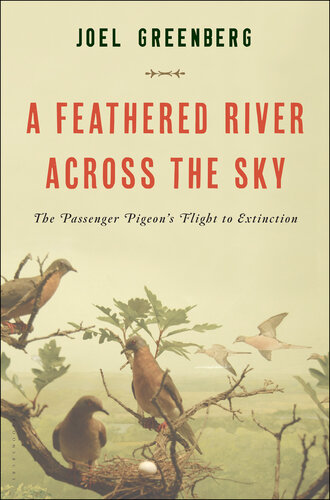
A Feathered River Across the Sky
The Passenger Pigeon's Flight to Extinction
کتاب های مرتبط
- اطلاعات
- نقد و بررسی
- دیدگاه کاربران
نقد و بررسی

September 30, 2013
September 1, 2014, will mark 100 years since Martha, a lone passenger pigeon living in the Cincinnati Zoo, died. To the best of our knowledge she was the last member of her species. Naturalist Greenberg, a research associate at the Field Museum and the Chicago Academy of Sciences Peggy Notebaert Nature Museum, effectively demonstrates that the extinction of passenger pigeons was a shocking event not simply because the species once enjoyed a population “that may have exceeded that of every other bird on earth, and its aggregations surpassed in numbers those of every other terrestrial vertebrate on the continent,” but also because its demise was so swift, with the population crashing from upwards of a billion to zero in about 40 years. Greenberg pulls together a wealth of material from myriad sources to describe the life and death of this species, describing the majesty of millions flying overhead for hours as well as the horror of tens of thousands of birds being slaughtered while they nested . He also examines the larger lessons to be learned from such an ecological catastrophe—brought on by commercial exploitation and deforestations, among other causes—in this “planet’s sixth great episode of mass extinctions.” Greenberg has crafted a story that is both ennobling and fascinating.

November 15, 2013
A shocking account of how the passenger pigeon, a bird found only in North America, became extinct. The year 2014 marks the centenary of the death of the last passenger pigeon known to be alive. In 1860, the bird's population was estimated to be somewhere between 1 billion and 3 billion. Four decades later, they were on the verge of extinction. More than 150 environmental institutions are involved in Project Passenger Pigeon, an effort that Chicago Academy of Sciences research associate Greenberg (Of Prairie, Woods, and Water: Two Centuries of Chicago Nature Writing, 2008, etc.) helped spearhead. The group works to spur consideration of current environmental issues, and the author hopes that his chronicle of the tragic events leading to the pigeon's extinction will "act as a cautionary tale so that it is not repeated." When Europeans arrived in North America, the passenger pigeon was the most abundant bird species, and it was a significant food source for Native Americans. The number of pigeons increased as European diseases decimated the Indian population. The pigeons were also a source of high-quality protein for the early colonists. Up until the post-Civil War period, a modus vivendi seemed to have been established between bird and human, and Greenberg cites a report of "a pigeon flight along the Ohio River that eclipsed the sun for three days." At the time, a record nesting of pigeons covered 850 miles. The author even hypothesizes that the white oak predominates in America because of the pigeon's preference for red-oak acorns. However, with the advent of railroads across the continent, it became profitable for commercial enterprises to sweep them up from prairie nesting sites and ship them by the tens of thousands to distant markets. Young squabs were particularly desirable, writes the author, but older live pigeons were also captured for trap-shooting contests, which were an occasion for significant gambling. A grim reminder of the many "reasons why species should be preserved."
COPYRIGHT(2013) Kirkus Reviews, ALL RIGHTS RESERVED.

Starred review from October 15, 2013
As the centenary of the passenger pigeon's extinction nears, Greenberg (A Natural History of the Chicago Region) offers this cautionary tale of the once most populous bird on earth. Ectopistes migratorius gathered in numbers hard to imagine--John James Audubon estimated a flock's size over Kentucky in 1813 at a billion or more--so many that the "sky was black with birds for three days." But as awesome as was their abundance, their slaughter, sadly, may be more poignant. When the plunder changed from hunters looking to put an easy meal on the table to professional "pigeoners" seeking to take advantage of national markets for pigeon meat, fat, and feathers, the gradual decline that began at the start of the 19th century became catastrophic by the 1870s. Greenberg's sifting of the historical record shows how a variety of factors--e.g., the use of the telegraph to report locations of immense nesting colonies to be pillaged, the completion of the eastern railroad network, complete habitat destruction--sealed the bird's fate. VERDICT The human folly depicted here is as deep as the pigeons were numerous, and the author's occasionally mordant comments on the grim events give the book an added charge, making his intended "teaching moment" certain. Highly recommended.--Robert Eagan, Windsor P.L., Ont.
Copyright 2013 Library Journal, LLC Used with permission.

























دیدگاه کاربران